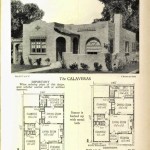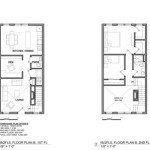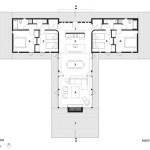How Do I Get a Floor Plan of My House?
Obtaining a floor plan of a house is a crucial step for homeowners considering renovations, property appraisals, insurance purposes, or simply wanting to have a detailed record of their property's layout. A floor plan provides a visual representation of the house, including the dimensions of rooms, the placement of walls, windows, doors, and other fixed features. Various methods are available for acquiring a floor plan, each with its own advantages and limitations. The optimal approach depends on factors such as the age of the house, the availability of original documentation, and the homeowner's budget and technical expertise.
One of the first avenues to explore is the existing documentation related to the property. This might include the original construction blueprints, architectural plans submitted during building permit applications, or previous appraisal reports. These documents, if available, offer the most accurate and complete representation of the house's floor plan. However, it's common for these records to be misplaced, inaccessible, or outdated due to subsequent alterations made to the property over time.
If historical documents are not readily available, alternative methods involve either creating a floor plan manually or hiring a professional to survey and draft one. These options offer greater control over the level of detail and accuracy, but they also require more time and effort. The manual approach involves using measuring tools and drafting techniques to create a floor plan from scratch, while hiring a professional guarantees a high degree of accuracy and adherence to industry standards.
Checking Existing Records and Official Sources
The initial search for an existing floor plan should focus on sources associated with the construction and development of the property. If the house is of relatively recent construction, there's a higher likelihood that detailed plans were created and preserved. Begin by contacting the local building department or planning office. These agencies typically maintain records of building permits and associated documents, including architectural plans and floor layouts submitted during the approval process. Accessing these records may require providing the property address, parcel number, or other identifying information. Some municipalities offer online portals where such information can be accessed remotely, while others require an in-person visit to the records department.
If the house is part of a planned community or subdivision, the homeowners association (HOA) or developer might have copies of the original architectural plans. These plans often include detailed floor plans, elevations, and site plans for all the houses within the development. Contacting the HOA or developer can be a valuable resource for obtaining a complete and accurate floor plan, especially if the house has not undergone significant alterations since its construction.
Reviewing existing mortgage documents and property appraisals can also provide clues to the existence of floor plans. Mortgage lenders often require appraisals as part of the loan approval process, and these appraisals may include a basic floor plan or room layout. Similarly, previous property appraisals conducted for insurance purposes or tax assessments might contain floor plans that can be used as a starting point. These plans may not be as detailed as architectural blueprints, but they can provide valuable information about the overall layout and dimensions of the house.
Homeowners should also explore their own personal records, including closing documents from the initial purchase of the property, renovation permits from previous projects, or homeowner's insurance policies. These documents may contain floor plans or other relevant information that can be used to reconstruct the layout of the house.
Creating a Floor Plan Manually
Creating a floor plan manually involves measuring the dimensions of each room and space within the house and then drafting a plan using graph paper, a computer-aided design (CAD) program, or specialized floor plan software. This method requires careful attention to detail and accurate measurements to ensure that the resulting floor plan is a reliable representation of the house's layout.
The first step in creating a manual floor plan is to gather the necessary tools and materials. This includes a measuring tape (preferably a laser measure for increased accuracy and convenience), graph paper, a pencil, an eraser, and a straightedge. It is also useful to have a notebook or clipboard for recording measurements and making notes. A laser measure significantly simplifies the measuring process, especially for larger rooms and irregular shapes. However, a traditional measuring tape can also be used, provided that measurements are taken carefully and consistently.
Begin by sketching a rough outline of the house's exterior walls on the graph paper. This outline does not need to be perfectly to scale at this stage, but it should accurately represent the overall shape and arrangement of the exterior walls. Then, proceed to measure the length and width of each room, as well as the thickness of the walls between rooms. Record all measurements in the notebook or on the graph paper, noting the location of doors, windows, and other fixed features. When measuring, ensure that the measuring tape is held straight and taut to avoid inaccuracies.
As you measure each room, pay close attention to the placement of doors, windows, fireplaces, and other architectural details. Measure the width and height of each door and window opening, as well as the distance from the corners of the room to each opening. Also, note the direction in which doors swing open, as this information is important for accurately representing the flow of traffic through the house. For fireplaces, measure the width and depth of the hearth, as well as the height of the chimney breast.
Once all the measurements have been taken, begin drafting the floor plan on the graph paper, using the measurements as a guide. Start by drawing the exterior walls to scale, using the rough outline as a template. Then, add the interior walls, doors, windows, and other features, ensuring that their dimensions and positions are accurately represented. Use a straightedge to draw straight lines and corners, and an eraser to correct any mistakes. As you draw the floor plan, double-check your measurements to ensure that everything is consistent and accurate.
Consider using computer software to create the floor plan. Various user-friendly floor plan software options are available, ranging from free online tools to more advanced professional-grade programs. These software applications often provide pre-designed templates and symbols for walls, doors, windows, and furniture, which can simplify the drawing process. They also allow you to easily scale and adjust the floor plan as needed, and to create multiple versions of the plan for different purposes.
Hiring a Professional Floor Plan Service
Engaging a professional floor plan service is often the most reliable and accurate method for obtaining a detailed and precise floor plan of a house. Professionals possess the necessary expertise, equipment, and software to create floor plans that meet industry standards and can be used for a variety of purposes, including renovations, appraisals, and insurance claims. While this option typically involves a higher upfront cost than creating a floor plan manually, it offers significant advantages in terms of accuracy, time savings, and professional quality.
When selecting a professional floor plan service, it's important to consider their qualifications, experience, and reputation. Look for services that employ licensed architects, drafters, or interior designers who have a proven track record of creating accurate and detailed floor plans. Check online reviews and testimonials to gauge the quality of their work and their level of customer service. Ask for references from previous clients and contact them to inquire about their experience with the service.
Before hiring a professional floor plan service, clearly communicate your specific needs and requirements. Explain the purpose for which you need the floor plan, such as renovations, appraisals, or insurance purposes. Provide the professional with any existing plans or documentation that you have available, as this can help them create a more accurate and comprehensive floor plan. Discuss the level of detail required, including the inclusion of furniture, appliances, and other fixtures. Obtain a detailed quote that outlines the cost of the service, the scope of work, and the estimated timeframe for completion.
During the measurement process, the professional will typically use laser measuring devices, electronic levels, and other specialized equipment to accurately measure the dimensions of each room and space within the house. They will also document the location of doors, windows, fireplaces, and other architectural details. In some cases, they may use 3D scanning technology to create a virtual model of the house, which can then be used to generate a precise floor plan. The measurement process may take several hours, depending on the size and complexity of the house.
After the measurements have been taken, the professional will use CAD software or other specialized programs to create the floor plan. The floor plan will typically include detailed dimensions, wall thicknesses, door and window locations, and other relevant information. The professional may also include furniture layouts, appliance placements, and other design elements, depending on the client's specific needs. The floor plan will be delivered in a digital format, such as PDF or DWG, which can be easily shared and printed. A hard copy of the floor plan can also be provided upon request.

How Do I Get A Floor Plan For My Property

9 Ways To Find Floor Plans Of An Existing House Blueprints Archid

Floor Plan Creator And Designer Free Easy App

How To Find The Original Floor Plans For Your House

House Plans How To Design Your Home Plan

House Plans How To Design Your Home Plan

My Dream House

Designing My Own House

House Plans How To Design Your Home Plan

How To Read A Floor Plan With Dimensions Houseplans Blog Com
Related Posts








